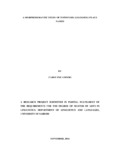| dc.description.abstract | This study discusses the meanings and morphology of Lulogooli placenames in Sabatia constituency, using the Causal theory of Names as proposed by Gareth Evans (1985) and the Frame theoretical framework as proposed by Charles Fillmore (1985). The study outlines the morphological and morphophonological patterns followed during the formation of Lulogooli toponyms and classifies them accordingly. The study attempts to bring out the types of meanings present in Lulogooli toponyms and how they are enhanced by morphological units of the words. Morphological processes such as prefixation, suffixation and reduplication and morphophonological processes like vowel deletion which are of importance to this study are examined. The research is largely descriptive and the data was collected through oral structured interviews, introspection and questionnaires. The findings of the study indicate that Lulogooli toponyms do follow distinct morphological patterns of formation and derivation is the main one others being inflection, and compounding. Secondly, the toponyms can be classified morphologically into those same patterns as derived, inflected, compounded and those following no pattern. Thirdly, a naming system for Lulogooli toponyms was established which identified the motivations behind the identified toponyms. The classification was done by placing toponyms into categories depending on their meanings. Lastly, referential and other cognitive meanings of eleven toponyms from the categories of the established naming system were identified. The Causal theory allowed for identification of the referential meanings from the community while the Frame theory explains how the meanings are cognitively retrieved from the speakers’ mental encyclopedic knowledge. Tables guide the morphological analysis of toponyms and Frames are used to define concepts that guide the retrieval of meanings. The results show that the meanings of morphemes contribute to the overall meaning of Lulogooli toponyms | en_US |



